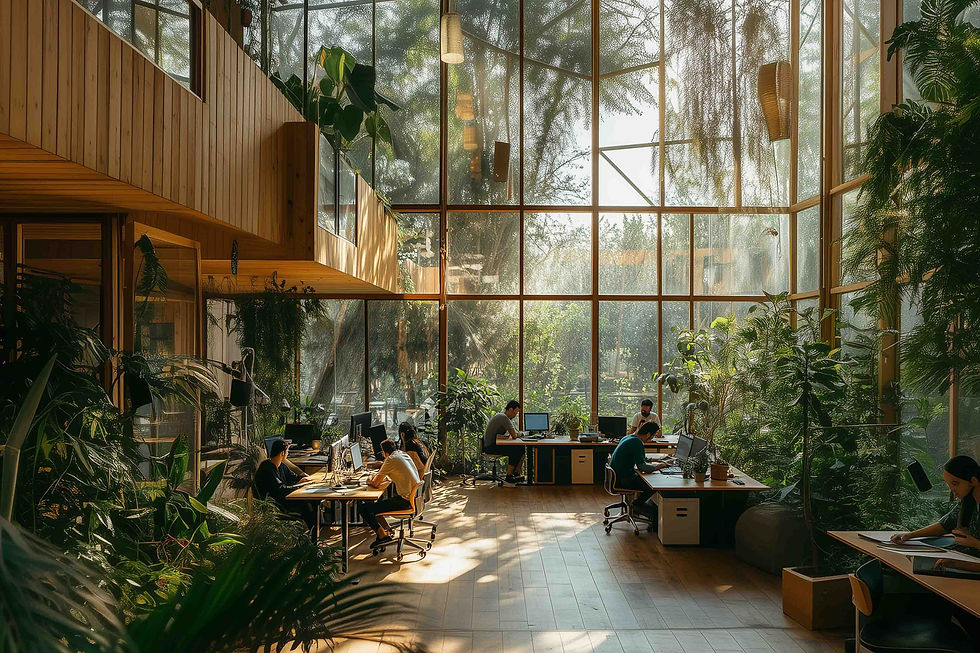From Digital Nomads to Digital Settlers: The Rise of Remote-First Communities
- Sebastián Gómez
- Aug 23
- 3 min read
Updated: Aug 28
The End of Endless Travel
For the last decade, the image of the digital nomad has dominated the future-of-work conversation: laptops on the beach, coffee shop offices, coworking spaces in Bali or Lisbon. But as remote work matures in 2025, many nomads are realizing that constant movement comes at a cost.
Burnout from travel, lack of stability, and the absence of true community are pushing digital nomads, remote teams, and entrepreneurs toward a new phase: Digital Settlers people who want the freedom of remote work without sacrificing roots, family, and belonging.

The Shift: From Mobility to Stability
Remote work is mainstream. A 2024 Gallup study showed that over 55% of knowledge workers now work remotely at least part-time. Remote is no longer an exception; it’s the standard.
Nomad fatigue is real. Research from Nomad List and FlexJobs points to rising levels of stress, loneliness, and financial unpredictability among long-term travelers.
Families and founders need more. While the early nomad movement worked for solo workers in their 20s, today’s demographic is older, often with children, or running distributed startups. They need stable housing, schooling, and infrastructure not just coworking and fast Wi-Fi.
Trend to watch: 2025 will be the year many nomads “put down roots,” not by going back to cities, but by choosing decentralized, intentional communities that combine freedom with permanence.

Why Remote Teams Are Looking for New Bases
For remote-first startups and teams, location is now a strategic decision:
Talent attraction: Offering employees the chance to live in healthier, safer, more inspiring environments is a perk that outshines a corporate office.
Cost efficiency: Running a team from a city like Berlin or San Francisco is expensive. Relocating to semi-rural, well-designed communities reduces overhead while boosting quality of life.
Retention & culture: Remote work can feel isolating; shared spaces and intentional living environments create real culture and cohesion.
According to Harvard Business Review (2024), teams with strong in-person retreat culture reported 25% higher retention compared to fully virtual teams.
Digital Settlers: What They’re Looking For
Through surveys and emerging projects worldwide, five common desires stand out among this new wave of “settlers”:
Self-sufficiency: Food, water, energy systems that reduce dependence on fragile global supply chains.
Education: Learning environments for children that go beyond traditional schools playful, flexible, community-based.
Community & safety: Real human connections, trust, and shared values something cities struggle to provide.
Space & nature: Privacy, clean air, and access to outdoors without long commutes or traffic.
Governance: Transparent rules, resident contracts, and a “live and let live” ethos that protects freedom while ensuring harmony.
These align perfectly with Freeth’m’s pillars: governance, self-sufficiency, longevity, intentional community, children, and business opportunities.
Case Study: Beyond Coliving
2015–2020: Coliving hubs and nomad hotspots flourished Bali’s Dojo, Lisbon’s Outsite, Mexico’s Playa del Carmen.
2021–2023: Retreat-style projects emerged team offsites, pop-up villages.
2024–2025: The new wave is permanent, decentralized towns places designed for settling, not just passing through.
Freeth’m is part of this third wave: not just shared housing, but private, self-sufficient towns where families, teams, and freedom-seekers can live, work, and thrive long-term.
Why Cities Can’t Compete
Cities are struggling under their own weight:
Noise, density, stress: Studies link city living to higher risks of anxiety and developmental issues in children.
Nutrient-deficient food supply: Urban diets depend heavily on processed imports.
Cost spiral: Rents, healthcare, and commutes eat into purchasing power.
Digital settlers don’t want to trade freedom for urban convenience they want both.
The Freeth’m Model: Building for Settlers
Freeth’m towns use a build-to-rent model that emphasizes:
Private & self-sufficient housing: Standalone homes, local materials, energy-efficient design.
Autonomous infrastructure: Microgrids, rainwater harvesting, aquaponics, geothermal systems.
Children’s “Kids World”: Flexible education, outdoor learning, after-school arts and crafts.
Work & business hubs: Coworking, office cubes, and fertile ground for entrepreneurship.
Longevity-focused lifestyle: Movement, natural food, sleep-friendly lighting, stress-free design
Settling Without Settling Down
The digital nomad movement was about proving we could work from anywhere. The digital settler movement is about choosing somewhere better.
For remote teams, families, and freedom-seekers, the future isn’t about endless flights and temporary Airbnbs it’s about stable, intentional towns where freedom and community coexist.
Freeth’m is building that future.
Join the Freeth’m Insiders community today. Get priority access to early previews, and a first look at how decentralized, self-sufficient towns can change the way you live, work, and raise your family.


Comments